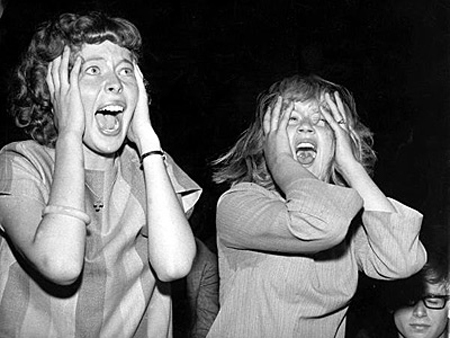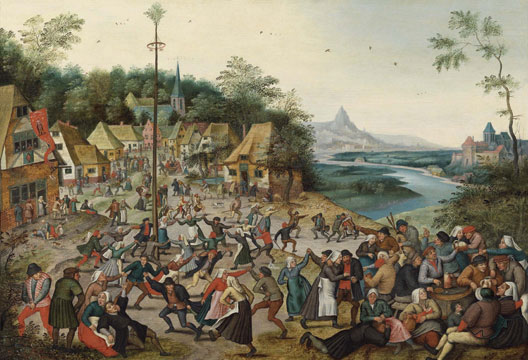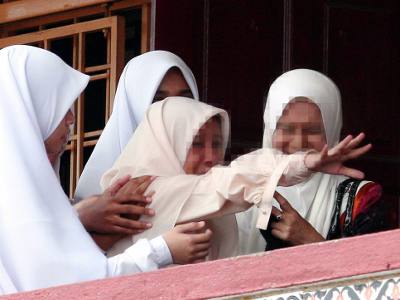What Is Mass Hysteria And Does It Only Happen When People Are Possessed By Evil Spirits?
Bizarre cases of mass hysteria have been recorded since the Middle Ages.
In the past week, SMK Pengkalan Chepa 2 in Kota Bharu, Kelantan has allegedly been hit with a mysterious case of mass hysteria since 11 April. To date, more than 100 students and teachers have fallen prey to the epidemic.
Students were unable to attend classes as some of their classmates - both female and male - and teachers were struck by hysteria since 11 April. The school was granted leave on Thursday, 14 April, during which a three-day cleansing ceremony was held to dispel any negative energy or supernatural powers from school grounds.
However, the hysteria appeared to have returned when school reopened on Sunday, 17 April despite school authorities having conducted a two-hour Quran recital and prayers in the morning before classes resumed. Media personnel, who were camped outside the school gates, reported hearing screams and shouting coming from within the school grounds on that day.
Additionally, three more schools have also been affected - SMK Pengkalan Chepa 1 (five girls), SMK Kemumin (20 students), and SMK Kubang Kerman 3 (eight students).
Some students - including those who were "possessed" - claimed to have seen black spectres and paranormal beings like pontianak and hantu pocong on school grounds. Several ustaz and bomohs have also been enlisted to rid the school's grounds of bad spirits.
Several students claimed to have captured images of a white spectre resembling a hantu pocong (ghostly figure wrapped in a shroud) at the school canteen, hall, and classrooms on Saturday night.
One student also recalled an incident where a female schoolmate, who was "possessed" for the second time, jumped off a flight of stairs but had her fall broken by several male students who were at the bottom of the staircase.
So, what exactly is mass hysteria?
Mass hysteria describes a near-panic situation where a group of people develop similar and contagious hysterical symptoms without an apparent cause or in response to an imaginary or actual threat.
The phenomenon is also known as epidemic hysteria, collective/group hysteria, collective obsessional behaviour, or mass psychogenic illness,
Mass hysteria begins when an individual starts showing symptoms such as uncontrollable emotional outbursts (e.g. screaming and shouting incoherently), nausea, muscle weakness, fits, headaches, and unconsciousness
These symptoms will soon manifest in those who are in close contact or proximity with the initial individual.
Instances of mass hysteria have been recorded as early as the Middle Ages, with bizarre symptoms such as nuns meowing for several hours every night, a dancing mania that led to the deaths of at least 15 people per day, and fits that were linked to witchcraft.
Pieter Bruegel's illustration of the Dancing Plague of 1518 in Strasbourg, Alsace.
Image via The PsychologistPublic outbreaks have also been recorded in the 20th and 21st century, including the Tanganyika laughter epidemic in a number of Tanzanian schools, a Pokemon-induced outbreak of nausea and seizures that affected 12,000 children, as well as several isolated cases in different schools in Malaysia, Brunei, and Sri Lanka.
What could cause an outbreak of mass hysteria?
Typically, there has been no obvious cause to be discerned in most cases. Supernatural cases have often been said to contribute to such events, while others cite fear, sadness, anxiety, and stress as main triggers for mass hysteria.
Many documented cases of mass hysteria have been credited to paranormal causes i.e. possession by evil spirits, which tend to induce fear and anxiety among a community, leading to them exhibiting symptoms of a hysterical epidemic.
John Waller, author of 'A Time to Dance, A Time to Die: The Extraordinary Story of the Dancing Plague of 1518', suggested that the symptoms of mass hysteria could most likely spread by the "power of suggestion" triggered by "fear, sadness and anxiety" among people in close proximity to each other. He added that the strain of exams is most often the main trigger of mass hysteria in students.
"Victims tend to be subject to severe psychological strain over the preceding weeks or months. One or more then develop a psychosomatic symptom, and those made suggestible by pent-up anxiety quickly follow suit. Before long, dozens are vomiting, fainting and screaming," he wrote.
"It takes only the right kind of fear, suggestion and false belief to trigger epidemic hysteria or mass delusions."
In regards to the Kota Bharu case, an Islamic scholar suggested that the effects of hot weather could have triggered mass hysteria, adding that media attention might have contributed to its spread to other schools
Speaking to New Straits Times, Dr. Mahyuddin Ismail, director of the Islamic centre and human development at Universiti Malaysia Pahang (UMP) said, “It could be due to several possibilities, including exaggerated or uncontrollable emotions prompted by the persistent hot spell which may have affected the students. Some might have fever or were feeling unwell and experiencing hallucinations."
Mahyuddin, who was involved in producing an anti-hysteria kit at UMP in 2012, also suggested that media reports could have contributed to the breakout in other schools.
"Since mass hysteria in one of the schools made headlines, news of the ghostly apparitions might have spread and affected students from other schools leading to uncontrollable emotions," he explained.
Who are most likely to exhibit symptoms of mass hysteria?
Mass hysteria affects males and females both young and old, though documented cases of mass hysteria indicate that the phenomenon largely affects women and teenage girls as well as those living in isolated communities.
Male students of SMK Tok Kera, Kuantan are left exhausted after a bout of hysteria in 2013.
Image via Sinar HarianHowever, Waller suggested that women and girls are over-represented as victims of hysterical outbreaks.
"In more misogynistic times, this was put down to women having more fragile nerves, or wombs with a tendency to rise out of the pelvis and compress other organs.
"Most experts now think that in many parts of the world, girls and women are more likely to succumb due to the frustrations of living in families and societies dominated by men," he wrote.
In Malaysia, cases of mass hysteria often involve the Malay female community - especially adolescents and those staying in hotels - as well as female factory workers in urbanised parts of the country
According to a medical journal article by Jin-Inn Teoh (1975), 29 schools in Peninsular Malaysia were affected by mass hysteria between 1962 to 1971, where most of the victims were Malay adolescent girls from secondary schools.
"The interpretation of all the outbreaks was connected with rural Malay belief, i.e., a person could be possessed by a jin (free spirit) at any time in his life, either accidentally or because he had interfered with the living places of these *jins*," Teoh wrote. To put it simply, the students were affected because one or more of them could have disturbed the spirits living in within the school compound.
Several cases have also been reported between 2001 and 2011 in Kuantan (35 students were struck with hysteria in 2009), Puchong (more than 30 girls started screaming, become violent and then collapsed during morning assembly in 2001), and Kuala Kubu Baru (more than 60 students became hysterical after one student claimed to have seen a white apparition on a bed in 2011).
How is mass hysteria treated?
Treatment could vary depending on the situation, but it is recommended to separate those who are affected and then addressing their respective symptoms to identify what triggered their hysterical fit.
In regards to cases related to supernatural factors, religious scholars and shamans are often called upon to deal with mass hysteria outbreaks in Malaysia i.e. bomohs or pawangs are enlisted to perform cleansing ceremonies to pacify the offended *jins*.





